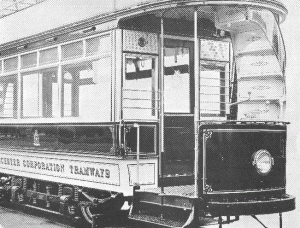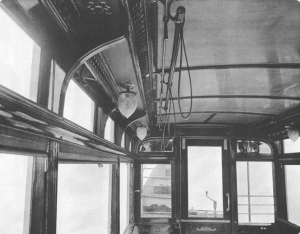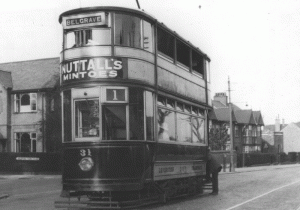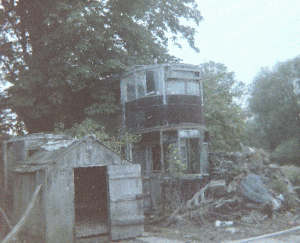Vehicle Profile
1904 Dick Kerr ERTCW Tramcar

Following an assessment period with two pilot evaluation vehicles Leicester Corporation Tramways placed an order with Dick Kerr of Preston for 58 new electric open-top tramcars. Car No.31 was delivered as part of this first batch of 58 cars and arrived in Leicester during March / April 1904. Each car was fitted out under the supervision of a resident engineer from Dick Kerr, and personally tested by him on site. They were 4 wheel open-top cars with seating for 22 inside and 34 outside, mounted on Brill 21E trucks of 6ft. wheelbase, and were powered by two DK ‘Type A’ 25hp motors. They were painted in a deep shade of crimson lake with cream rocker panels, window frames and decency panels and white wire mesh. Oak, ash, mahogany and maple all had a place in the bodywork and each car was reported to have cost £510 each. The original paintwork consisted of ten coats of primer, undercoat and enamel. The livery was finished with gold leaf lining and the appearance of Leicester’s new cars was quoted in Tramway and Railway World as “not being surpassed by anywhere else in their quality”.

In Service:
Leicester’s electric tramway system opened on the 18th May, 1904 in glorious weather shining on a Town Hall reception that included titled gentry, the Mayor and Councillor Samuel Flint (Chairman of the Tramways Committee). After a subsequent ceremony at the LERO power station in Painter St; the power was switched on and the party were conveyed by electric traction to the new Abbey Park Road depot where they transferred to three decorated trams for a ceremonial tour of the system. At 7pm that evening car No.31 along with its sisters was called into action to give free rides to the citizens of Leicester. Every car was reported to have been packed with passengers until the last one returned to the depot at 11pm that night.
Over the next five months No.31 set into its stride and as new routes opened she was joined in October by a second batch of 40 cars to cater for the increased route mileage. Car No. 76 which is preserved at the Crich Tramway Village is of this second batch. The total fleet reached an impressive 178 cars in the early 1920s and in 1923 Leicester’s first completely enclosed car made its way onto the scene. It is not known when No.31 received its very own covered top or indeed whether it was converted straight into a fully enclosed car from an open-topper or if it had a roof with open balconies such as the appearance of No.76 at Crich. In fact, very little is known of the life of No.31 and we only know of 3 photographs of this particular car whilst in regular traffic. It appears that it was simply one of many that led an unremarkable yet dependable existence prior to the First World War, throughout the inter-war years, through the Second World War and into the 1940s.

She is known to have been photographed in 1936 in the original Crimson and Cream livery with covered top and fully enclosed ends. As with all cars that existed into the post war years she also received the later style maroon livery that had been introduced from 1937. In 1943 she was photographed in her maroon livery with additional wartime precautions and headlamp masking, equipped for blackout and sporting white edge markings to aid boarding passengers in the dark.
Withdrawal:
No.31s eventual withdrawal came in 1949 with the closure of the vast majority of the tram network. She survived almost to the very end in regular traffic, and was withdrawn early in 1949 where her body was then lifted and her truck recovered for salvage. She was reported in March 1949 as having been sold and despatched to Fred Edlin’s Garage located at Blaby Wharf; leaving just a handful of cars in traffic to soldier on until the end finally came on November 9th 1949.
Fred Edlin’s of Blaby Wharf:
A significant number of Leicester tram bodies were sold and delivered to Edlin’s of Blaby and it is unclear whether Edlin’s were contracted to break the bodies up (possibly to prevent them cluttering Abbey Park Road depot) or if in fact Edlin’s actually sold them all on for further use. Any help on this from readers would be most welcome but if they really were all sold on for future use as hen houses, garden sheds, summer retreats, cricket facilities etc then research indicates that there should be about 50 cars that were dispatched for use elsewhere! Of the 50 or so that went to Edlin’s further research so far has only revealed the last locations of about 10. Certainly Crich No.76 was an ‘Edlin’s car’ and having been withdrawn earlier in 1947 had made it all the way to East Cowick near Snaith in Yorkshire. Fred Edlin’s haulage business was absorbed into the 1948 Transport Act’s Nationalisation of the heavy haulage industry and it subsequently emerged as part of the Pickfords operation.
The Markfield Five:

Alice Spiby of Markfield, Leicestershire was sorry to see Leicester losing its trams and had always had a soft spot for them. In 1949, recognising that tram bodies could make useful outbuildings on her farm, she arranged to purchase 5 bodies from Fred Edlin. She paid £5 each for them and a further £25 for Pickfords to deliver them! Car No.31 along with No’s 27, 59, 95 and 20 (which was built as 162) were all despatched that year to Markfield for their final journey to their final use and resting place. For some unknown reason, (possibly down to cost or ease of transport?) only car No.31 arrived at Markfield with an upper deck, the others having had them removed prior to despatch.
No.31 subsequently then spent the next 60 years resting on bricks in use providing a home for chickens downstairs and piglets upstairs! She has survived the ravages of time incredibly well considering her location in one of the highest points in Leicestershire where snow is still a common sight most winters! She has witnessed the collapse and demise of her neighbouring four companions and survived (with a few scars!) the removal of her staircases, upper deck seating, light fittings, and brass work which she sacrificed to the hands of preservationists in the cause of Leicester No.76, Derby No.1 (both Crich exhibits) and the Burton & Ashby car No.14 (now hidden away in Detroit, USA).
Leicester Tram 31 Group:
Many photographers, enthusiasts and souvenir hunters have paid her a visit over her 60-year stay in Markfield and No.31 has now spent more years as a farm out-building than she did in service to the city!
However, They say that good things come to those who wait and on the 60th anniversary of the last tram we are pleased to announce that Alice Spiby’s Son John, has now passed ownership of No.31 to a new group of friends and to a new outlook which will hopefully one day see her looking as she did in the final years of tramcar service.
My mum was a clippie on the trams during the war whilst my dad was in the army. I am the baby of the family born in 1946 but have a brother and sister 12 and 14 years older than me. I was brought up with stories from both parents about the war. My favourite was when Leicester suffored a night of really bad bombing and my mum left the tram full of passengers at the clock tower to go to my gran’s to see if my brother and sister were ok. Another story was that if they could afford it they would stop the tram and order fish and chips and collect them on the way back. My mum died over 25 years ago but a few months ago I found an old photo of her in her uniform with friends with a tram in the background. Unfortunately I have now lost the photo. My mum’s name was Alice Blyth, We have been to Crich several times and I always wonder if my mum was ever clippie on that tram.
I live in Glenfield. and would love to see this tram. Is this possible?
My dad was a Leicester man born 1907. I was only a tot when the cars went so never saw them but I inherited his love of trams and he took me on the London cars.I was taken by Dad to be shewn the tramway sights that still remained before the old Leicester disappeared. I am modelling a Leicester car to go round my garden in his memory. Good luck to car #31!
Hi
Loved your photos of the old tram body. I thought you might like to see our recent photos of a rediscovered tram. Didn’t find any tram tickets or coins. This used to be a double decker and is now standing on a chassis with solid rubber tyres. Have a look and let me know what you think.
http://www.flickr.com/photos/61400165@N02/sets/72157627092359377/
Dear Nigel,
Thanks so much for the link to your recent discovery! It looks like its well hidden! Your flickr pics suggest Yorkshire as the location – could this be a former Hull tram? The tram looks very similar to one I saw in Skipsea which is thought to be a Milnes Tram Car built as a double decker for Hull. If you google ‘skipsea tram’ and look at the image search it should bring you some pics up. I’m sure yours is one from the same batch?? Thats a guess anyway! Looks like somebody has cut out the bulkhead and re-inserted it as the doorway in. What a great find! All the best, Steve.
Steve,
Once restored what do you intend to do with the car?
Andy
My grandfather was a conductor on the Leicester Trams and by all accounts he was a very pedantic man. A story, told at every Christmas party, was, of how he made the Lady Mayoress pay full fare just two days outside of her official twelve months of free travel. I was born just at the end of the war (WW2) and often made my father wait for a tram rather than a bus. As I have posted elsewhere, I would pretend to drive it whilst standing on the upstairs balcony.
Hi Andy, Thanks for your question. When we can get to a point in the rebuild when people can see that we are making good progress we can consider a long term home for the car. There’ll be a period of touring and profile raising where we hope to have the lower saloon on a tow-able trailer. We have identified possible sources for a truck and the appropriate control gear and eventually all these parts can be re-united. We have excellent friends in the Leicester Museum of Technology and the Leicester Transport Heritage Trust and so both represent worthy homes for the car. It would be lovely to see Car 31 actually run and the National Tramway Museum is not the world away from Leicester so who knows! I guess stay tuned is the best advice!
I was evacuated to Leicester in 1940 to Knighton Grange Road quite near the Stoneygate terminus and rode the trams into the city regularly. They did not run on Sundays so we had to walk to church in Bond Streey, now demolished. They had hard wooden seats I remember. The tracks in the roads were lethal to us on our Bikes